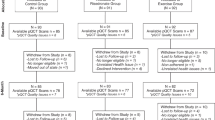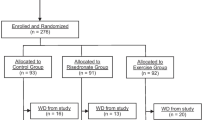Abstract
The aim of this study was to examine the association of exercise frequency and calcium intake (CI) with change in regional and total bone mineral density (BMD) in a group of postmenopausal women completing 4 years of progressive strength training. One hundred sixty-seven calcium-supplemented (800 mg/day) sedentary women (56.1±4.5 years) randomized to a progressive strength training exercise program or to control were followed for 4 years. Fifty-four percent of the women were using hormone therapy (HT) at baseline. At 1 year, controls were permitted to begin the exercise program (crossovers). The final sample included 23 controls, 55 crossovers, and 89 randomized exercisers. Exercisers were instructed to complete two sets of six to eight repetitions of exercises at 70–80% of one repetition maximum, three times weekly. BMD was measured at baseline and thereafter annually using dual-energy X-ray absorptiometry. Four-year percentage exercise frequency (ExFreq) averaged 26.8%±20.1% for crossovers (including the first year at 0%), and 50.4%±26.7% for exercisers. Four-year total CI averaged 1,635±367 mg/day and supplemental calcium intake, 711±174 mg/day. In adjusted multiple linear regression models, ExFreq was positively and significantly related to changes in femur trochanter (FT) and neck (FN), lumbar spine (LS), and total body (TB) BMD. Among HT users, FT BMD increased 1.5%, and FN and LS BMD, 1.2% ( p <0.01) for each standard deviation (SD) of percentage ExFreq (29.5% or 0.9 days/week). HT non-users gained 1.9% and 2.3% BMD at FT and FN, respectively, ( p <0.05) for every SD of CI. The significant, positive, association between BMD change and ExFreq supports the long-term usefulness of strength training exercise for the prevention of osteoporosis in postmenopausal women, especially HT users. The positive relationship of CI to change in BMD among postmenopausal women not using HT has clinical implications in light of recent evidence of an increased health risk associated with HT.



Similar content being viewed by others
References
USDHHS (2004) Bone Health and Osteoporosis: A Report of the Surgeon General. US Department of Health and Human Services, Public Health Service, Office of the Surgeon General: Rockville, MD, USA
Cummings SR, Black DM, Nevitt MC (1993) Bone density at various sites for prediction of hip fractures. Lancet 341:72–75
Vestergaard P, Rejnmark L, Mosekilde L (2001) Hip fracture prevention: cost-effective strategies. Pharmacoeconomics 19(5, Part 1):449–68
Wolff I, Van Cronenbourg JJ, Kemper HCG, Kostense PJ, Twisk JWR (1999) The effect of exercise training programs on bone mass: A meta-analysis of published controlled trials in pre- and postmenopausal women. Osteoporos Int 9:1–12
Chilibeck PD, Sale DG, Webber CE (1995) Exercise and bone mineral density. Sports Med 19(2):103–22
Nelson M, Fiatarone M, Morganti C, Trice I, Greenberg RE, Vans W (1994) Effects of high intensity strength training on multiple risk factors for osteoporotic fractures. JAMA 272:1909–1914
Kerr D, Morton A, Dick I, Prince R (1996) Exercise effects on bone mass in postmenopausal women are site-specific and load-dependent. J Bone Miner Res 11:218–225
Kohrt WM, Ehsani AA, Birge SJ Jr (1997) Effects of exercise involving predominantly either joint-reaction or ground-reaction forces on bone mineral density in older women. J Bone Miner Res 12(8):1253–1261
Going S, Lohman T, Houtkooper L, Metcalfe L, Flint-Wagner H, Blew R, Stanford V, Cussler EC, Martin C, Teixeira P, Harris M, Milliken L, Weber J (2003) Effects of exercise on bone mineral density in calcium-supplemented postmenopausal women with and without hormone replacement therapy. Osteoporos Int 14(8):637–644
Sinaki M, Itoi E, Wahner HW, Wollan P, Gelzcer R, Mullan BP, Collins DA, Hodgson SF (2002) Stronger back muscles reduce the incidence of vertebral fractures: a prospective 10-year follow-up of postmenopausal women. Bone 30(6):836–841
Snow CM, Shaw JM, Winters KM, Witzke KA (2000) Long-term exercise using weighted vests prevents hip bone loss in postmenopausal women. J Gerontol 55:M489–M491
Heikkinen J, Kyllonen E, Kurttila-Matero E, Wilen-Rosenqvist G, Lankinen KS, Rita H, Vaananen HK (1997) HRT and exercise: effects on bone density, muscle strength and lipid metabolism. A placebo controlled 2-year prospective trial on two estrogen-progestin regimens in healthy postmenopausal women. Maturitas 26(2):139–149
McMurdo ME, Mole PA, Paterson CR (1997) Controlled trial of weight-bearing exercise in older women in relation to bone density and falls. BMJ 314(7080):569
Suzuki Y, Davison KS, Chilibeck PD (2003) Total calcium intake is associated with cortical bone mineral density in a cohort of postmenopausal women not taking estrogen. J Nutr Health Aging 7(5):296–299
Uusi-Rasi K, Sievanen H, Pasanen M, Oja P, Vuori I (2002) Associations of calcium intake and physical activity with bone density and size in premenopausal and postmenopausal women: a peripheral quantitative computed tomography study. J Bone Miner Res 17(3):544–552
Yahata Y, Aoyagi K, Okano K, Yoshimi I, Kusano Y, Kobayashi M, Moji K, Takemoto T (2002) Metacarpal bone mineral density, body mass index and lifestyle among postmenopausal Japanese women: relationship of body mass index, physical activity, calcium intake, alcohol and smoking to bone mineral density: the Hizen-Oshima study. Tohoku J Exp Med 196(3):123–129
Holbrook TL, Barrett-Connor E (1995) An 18-year prospective study of dietary calcium and bone mineral density in the hip. Calcif Tissue Int 56:364–367
Ruml LA, Sakhaee K, Peterson R, Adams-Huet B, Pak CY (1999) The effect of calcium citrate on bone density in the early and mid-postmenopausal period: a randomized placebo-controlled study. Am J Ther 6(6):303–311
Prince R, Devine A, Dick I, Criddle A, Kerr D, Kent N, Price R, Randell A (1995) The effects of calcium supplementation (milk powder or tablets) and exercise on bone density in postmenopausal women. J Bone Miner Res 10:1068–1075
Devine A, Dick IM, Heal SJ, Criddle RA, Prince RL (1997) A 4-year follow-up study of the effects of calcium supplementation on bone density in elderly postmenopausal women. Osteoporos Int 7(1):23–28
Cussler EC, Lohman TG, Going SB, Houtkooper LB, Metcalfe LL, Flint-Wagner HG, Harris RB, Teixeira PJ (2003) Weight lifted in strength training predicts bone change in postmenopausal women. Med Sci Sports Exerc 35(1):10–17
Thomson CA, Giuliano A, Rock CL, Ritenbaugh CK, Flatt SW, Faerber S, Newman V, Caan B, Graver E, Hartz V, Whitacre R, Parker F, Pierce JP, Marshall JR (2003) Measuring dietary change in a diet intervention trial: comparing food frequency questionnaire and dietary recalls. Am J Epidemiol 157(8):754–762
Maurer J, Harris MM, Stanford VA, Lohman TG, Cussler E, Going SB, Houtkooper LB (2005) Dietary iron positively influences bone mineral density in postmenopausal women on hormone replacement therapy. J Nutr 135(4):863–869
Lohman T, Going S, Pamenter R, Hall M, Boyden T, Houtkooper L, Ritenbaugh C, Bare L, Hill A, Aickin M (1995) Effects of resistance training on regional and total bone mineral density in premenopausal women: a randomized prospective study. J Bone Miner Res 10(7):1015–1024
Sievanen H, Kannus P, Nieminen V, Heinonen A, Oja P, Vuori I (1996) Estimation of various mechanical characteristics of human bones using dual energy X-ray absorptiometry: Methodology and precision. Bone 18:17S–27S
Metcalfe L, Lohman T, Going S, Houtkooper L, Ferreira D, Flint-Wagner H, Guido T, Martin J, Wright J, Cussler E (2001) Postmenopausal women and exercise for the prevention of osteoporosis: The Bone, Estrogen, and Strength Training (BEST) study. ACSM’s Health & Fitness Journal 5(3):6–14
Barrett-Connor E, Wehren LE, Siris ES, Miller P, Chen YT, Abbott TA 3rd, Berger ML, Santora AC, Sherwood LM (2003) Recency and duration of postmenopausal hormone therapy: effects on bone mineral density and fracture risk in the National Osteoporosis Risk Assessment (NORA) study. Menopause 10(5):412–419
Greendale GA, Espeland M, Slone S, Marcus R, Barrett-Connor E (2002) Bone mass response to discontinuation of long-term hormone replacement therapy: results from the Postmenopausal Estrogen/Progestin Interventions (PEPI) Safety Follow-up Study. Arch Intern Med 162(6):665–672
SPSS (2003) Statistic program for the social sciences, Version 12.0, Chicago, IL
Burr DB (1997) Muscle strength, bone mass, and age-related bone loss. J Bone Miner Res 12(10):1547–1551
Teixeira PJ, Going SB, Houtkooper LB, Metcalfe LL, Blew RM, Flint-Wagner HG, Cussler EC, Sardinha LB, Lohman TG (2003) Resistance training in postmenopausal women with and without hormone therapy. Med Sci Sports Exerc 35(4):555–562
Rhodes RE, Martin AD, Taunton JE, Rhodes EC, Donnelly M, Elliot J (1999) Factors associated with exercise adherence among older adults. An individual perspective. Sports Med 28(6):397–411
Kohrt WM, Ehsani AA, Birge SJ Jr (1998) HRT preserves increases in bone mineral density and reductions in body fat after a supervised exercise program. J Appl Physiol 84(5):1506–1512
Cauley JA, Robbins J, Chen Z, Cummings SR, Jackson RD, LaCroix AZ, LeBoff M, Lewis CE, McGowan J, Neuner J, Pettinger M, Stefanick ML, Wactawski-Wende J, Watts NB (2003) Effects of estrogen plus progestin on risk of fracture and bone mineral density: the Women’s Health Initiative randomized trial. JAMA 290(13):1729–1738
Kohrt WM, Snead DB, Slatopolsky E, Birge SJ Jr (1995) Additive effects of weight-bearing exercise and estrogen on bone mineral density in older women. J Bone Miner Res 10(9):1303–1311
CDC (2002) Dietary intake of macronutrients, micronutrients, and other dietary constituents: United States, 1988–94. Data from the National Health Examination Survey, the National Health and Nutrition Examination Surveys, and the Hispanic Health and Nutrition Examination Survey Series 11, No. 245. Centers for Disease Control, Atlanta, GA, USA
Alaimo K, McDowell M, Briefel R, Bischof A, Caughman C, Loria C, Johnson C (1994) Dietary intake of vitamins, minerals, and fiber of persons ages 2 months and over in the United States: Third National Health and Nutrition Examination Survey, Phase 1, 1988–1991. NCHS (National Center for Health Statistics) Adv Data 258:1–26
Michaelsson K, Bergstrom R, Holmberg L, Mallmin H, Wolk A, Ljunghall S (1997) A high dietary calcium intake is needed for a positive effect on bone density in Swedish postmenopausal women. Osteoporos Int 7(2):155–161
Riggs BL, O’Fallon WM, Muhs J, O’Connor MK, Kumar R, Melton LJ 3rd (1998) Long-term effects of calcium supplementation on serum parathyroid hormone level, bone turnover, and bone loss in elderly women. J Bone Miner Res 13(2):168–174
Shea B, Wells G, Cranney A, Zytaruk N, Robinson V, Griffith L, Ortiz Z, Peterson J, Adachi J, Tugwell P, Guyatt G (2002) Meta-analyses of therapies for postmenopausal osteoporosis. VII. Meta-analysis of calcium supplementation for the prevention of postmenopausal osteoporosis. Endocr Rev 23(4):552–559
Aloia JF, Vaswani A, Yeh JK, Ross PL, Flaster E, Dilmanian FA (1994) Calcium supplementation with and without hormone replacement therapy to prevent postmenopausal bone loss. Ann Intern Med 120(2):97–103
Heaney RP (2001) Constructive interactions among nutrients and bone-active pharmacologic agents with principal emphasis on calcium, phosphorus, vitamin D and protein. J Am Coll Nutr 20 [Suppl 5]:403S–409S; discussion 417S–420S
Nieves JW, Komar L, Cosman F, Lindsay R (1998) Calcium potentiates the effect of estrogen on bone mass: review and analysis. Am J Clin Nutr 67:18–24
Boucher A, D’Amour P, Hamel L, Fugere P, Gascon-Barre M, Lepage R, Ste-Marie LG (1989) Estrogen replacement decreases the set point of parathyroid hormone stimulation by calcium in normal postmenopausal women. J Clin Endocrinol Metab 68(4):831–836
NIH (1994) Consensus conference. Optimal calcium intake. NIH Consensus Development Panel on Optimal Calcium Intake. JAMA 272(24):1942–1948
Acknowledgements
This study was funded by NIH AR39939 and Mission Pharmacal. The authors wish to express their gratitude to Mission Pharmacal (San Antonio, TX, USA) for the generous donation of calcium supplements (Citracal(r)) for the study. The authors wish to express the sincere appreciation to the BEST study participants for their many contributions and dedication to improving women’s health
Author information
Authors and Affiliations
Corresponding author
Rights and permissions
About this article
Cite this article
Cussler, E.C., Going, S.B., Houtkooper, L.B. et al. Exercise frequency and calcium intake predict 4-year bone changes in postmenopausal women. Osteoporos Int 16, 2129–2141 (2005). https://doi.org/10.1007/s00198-005-2014-1
Received:
Accepted:
Published:
Issue Date:
DOI: https://doi.org/10.1007/s00198-005-2014-1




